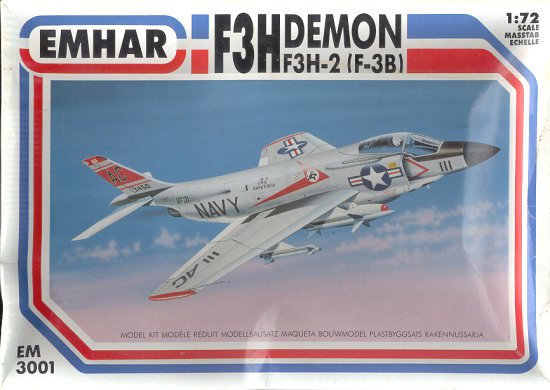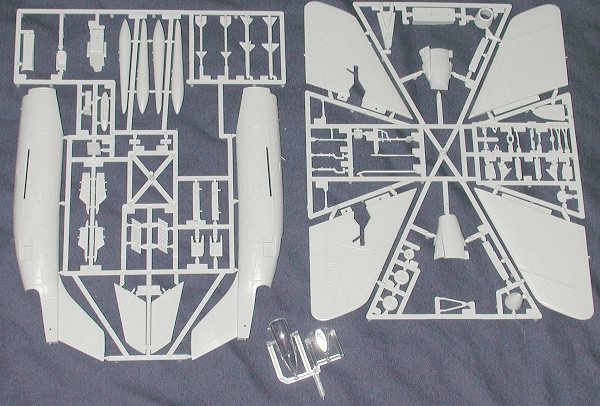
|
KIT: |
Emhar 1/72 F3H Demon |
|
KIT # |
3001 |
|
PRICE: |
$10.00 MSRP when new |
|
DECALS: |
two options |
|
REVIEWER: |
Scott Van Aken |
|
NOTES: |

|
HISTORY |
The prototype first flew in 1951 and first test flights of the operational design were in January 1953. The engine was a major disappointment, producing only half of the expected power it was temperamental and unreliable, of 35 F3H-1 aircraft that were flown with the J-40 engine eight were involved in major accidents. The J-40 engined aircraft were grounded and a new engine was sought. (In fact, brand new J-40 powered Demons were barged or trucked directly to training schools and never flown, starting an investigation into fraud by members of Congress. Things never change.) The best alternative was destined for the F-100 Super Sabre and subsequent F3Hs were fitted with the Allison J-71 engine (also used in the B-66/A3D) and designated the F3H-2. While more reliable this new engine had to be 'shoe-horned' into the airframe and with less power than needed did little for the aircraft's performance.
The first Demon with a J-71 flew in October 1954. Another problem was with the ejector seats, initial versions could fail to operate and had to be replaced with Martin Baker models. Despite the problems in 1956 the Navy ordered 239 F3H-2s and the first were deployed in March 1956. 522 Demons were built up to the end of production in November 1959. It was the Navy's first all-weather interceptor with radar and the Raytheon Sparrow or Sidewinder AAM and remained the Navy's front-line fighter until 1962 when it was succeeded by the F-4 Phantom II. Although developed during the Korean War it did not see action, although it flew over Lebanon and Quemoy in 1958.
|
THE KIT |

Emhar has had a less than sparkling reputation amongst modelers. It seems as if they have fallen a bit short of what was expected of them, and that is a shame. Emhar has had the good sense to provide some very much needed kits in 1/72 that include the F-94C and FJ-4 Fury. While not exactly Hasegawa, they are not bad kits and with a bit of that good old modeling talent can be made into very nice shelf models.
The kit is molded in a Matchbox looking manner with square sprues that are so typical of Matchbox kits. The detailing is engraved, and is a little bit overdone for the scale. Painting will tone them down. As you know, I'm a bit obsessive about sink marks, ejector pin marks and flash. There is none of the latter, few of the middle thing and the sink marks are only on thick bits such as gear doors. The clear bits are a bit thick and somewhat distorted, but quite adequate. If you want thin and clear, buy a Falcon canopy set.
 Cockpit
is basic and consists of a tub, generic bang seat, instrument panel and
control stick. There is no detail on the instrument panel or side
consoles nor is there a decal for these. A bit of an omission if you ask
me. There is no gear or speed brake well detail. The wing and fuselage
speed brakes are separate in case you want to display them open, a rarity
on the ground. Landing gear are fairly well done. A separate tail hook is
also provided. Stores included two Sparrow, two Sidewinder and two drop
tanks with pylons for them. You'll need nose weight to prevent this from
being a tail sitter.
Cockpit
is basic and consists of a tub, generic bang seat, instrument panel and
control stick. There is no detail on the instrument panel or side
consoles nor is there a decal for these. A bit of an omission if you ask
me. There is no gear or speed brake well detail. The wing and fuselage
speed brakes are separate in case you want to display them open, a rarity
on the ground. Landing gear are fairly well done. A separate tail hook is
also provided. Stores included two Sparrow, two Sidewinder and two drop
tanks with pylons for them. You'll need nose weight to prevent this from
being a tail sitter.
Instructions are the usual pictorial construction steps on one side of the paper. Some color info is given during these steps. Nothing fancy, but sufficient. The decals are well printed and a bit thick, reminding me of Modeldecals. Markings are provided for two light gull grey over white Demons. One of VF-31 in 1960 as shown on the box art. The other is from VF-64 in 1958. There are several aftermarket sheets for this kit and while not a snap to find, one should seek them out for optional markings.
|
CONCLUSIONS |
You want an F3H in 1/72 then there is this kit and the Rareplanes vacuformed kit. The Rareplanes kit is probably more accurate, but this one will be easier to build!
If you would like your product reviewed fairly and quickly by a site that has over 200,000 visitors a month, please contact me or see other details in the Note to Contributors.